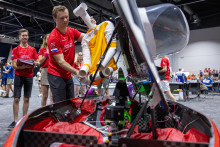Is solar energy the future of transport?
Morales Masis: ‘Yes, I think solar cars are the future. The amount of cars keeps increasing, and so we need clean cars driving on clean energy. If we integrate solar panels into electric cars and have charging stations powered by solar panels, that is the future. And it will happen, in my opinion. We will see this very soon.’
Why isn’t it happening already?
‘It requires some more research and development. The technology is ready, but every part can still be optimized. We need to make solar cells with higher efficiency, batteries with higher storage capacity – and we need to make it all cheaper. We need somebody with a strong vision to move this development forward, just like Elon Musk and Tesla. We need somebody who does the same for solar cars. There is already a company in Eindhoven developing a consumer ready solar car: Lightyear. Actually, I’ve just learnt that some former Solar Team Twente members work there. So you can see that the development and innovation is happening and companies will pick it up.’
What do we need to make solar cars a daily occurrence?
‘Car companies need to make a shift in their production lines and implement the right solar cells and batteries. However, price is a constraint. One of the main drawbacks right now is the costs. It is very expensive for “normal people” to buy such a car. Moreover, esthetics are very important if you want people to buy a car and, up to now, most solar cars were considered ugly. We’d also need to improve our general infrastructure and have a lot more charging stations. Instead of gas stations, we should have charging stations running on clean energy. The advantage of a solar car is that it is constantly charging – the solar cells on the roof constantly charge the battery where the energy is stored. However, you can have a bad rainy day and need to charge the battery on the way.’
monica morales masis
Monica Morales-Masis is Tenure track researcher at the University of Twente. Her work focuses on the development and study of new materials for optoelectronic devices, with strong focus on solar cells. She is head of the Optoelectronics Materials group, part of the Inorganic Materials Science (IMS) chair at the Faculty of Science and Technology.
Monica Morales Masis. Photo by Frans Nikkels
What are the technical challenges that need to be solved?
‘We need to think of the source materials we use for solar cells and batteries, because many of them are not abundant. For example, cobalt and indium – which are used in batteries and solar cells. They are called critical raw materials because they are of economic importance for the EU but also have a supply risk. Silver is widely used in solar cells too, but it is very expensive. On the other hand, they are already used in solar cell production nowadays, so that is not a problem solar cars would create.
In my research, I’m working on new materials that we could use in solar cells. I’m trying to find replacements for these critical raw materials or to find a way to use less of them. The materials are also greatly contributing to the high price of solar cars, I believe. On top of this, we need to find ways to improve the efficiency of the solar cells using simple and low-cost (or low energy consuming) methods for their production.’
Let’s say all these challenges are overcome, are there any cons of a future where we all drive solar cars?
‘We need to think about the number of cars we want to produce because producing the cars, the batteries and solar cells also have an environmental impact. We should not forget about public transport and motivating people to be active, to cycle and walk. We don’t want to create a culture where everyone drives a car because it’s considered environmentally friendly. In the end, you should still create a world where people use bikes and public transport.’









